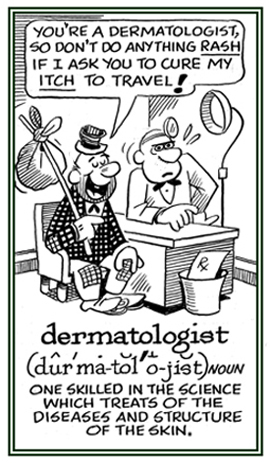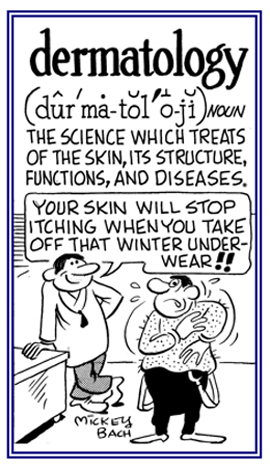dermo-, derm-, derma-, dermato-, dermat-, -derm, -derma, -dermatic, -dermatous, -dermis, -dermal, -dermic, -dermoid, -dermatoid
(Greek: skin)
2. The science or study of skin markings or patterns; especially, those of the fingers, hands, and feet; also, such skin markings themselves.
3. The science of skin patterns, especially fingerprints.

Go to this Word A Day Revisited Index
so you can see more of Mickey Bach's cartoons.

Go to this Word A Day Revisited Index
so you can see more of Mickey Bach's cartoons.
2. A fungal infection of the skin; especially, of moist parts of the body that are covered by clothing.
On rare occasions, other vital internal organs; such as, the lungs, heart, bowels, and eyes can also be damaged.
In addition, certain internal complications including calcium deposits in damaged tissue (calcification) are seen more commonly in childhood-onset dermatomyositis; however, adults with classical dermatomyositis have a relatively greater risk of developing internal cancers in association with their dermatomyositis.
The muscles used for swallowing food can be affected by dermatomyositis resulting in a choking sensation when the patient attempts to swallow solid foods or liquids.
Some patients initially develop the skin rash but can go for 20 years or longer without experiencing muscle weakness or amyopathic dermatomyositis.
There are two forms of dermatomyositis: the classical form and the clinically amyopathic form or a-, "no" or "without", myopathic, "muscle disease".
- Classical dermatomyositis consists of a characteristic skin rash and muscle weakness most often noticed initially in the shoulders and hips.
- In clinically amyopathic dermatomyositis, the skin rash can be present for long periods of time (six months or longer) without the appearance of muscle weakness.


